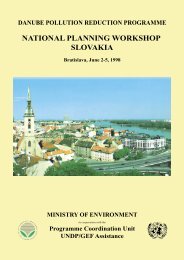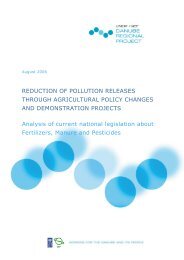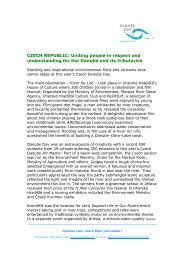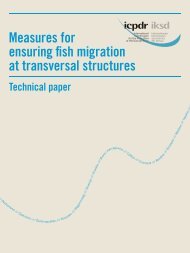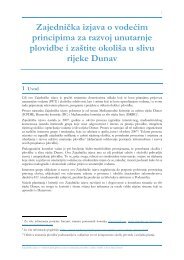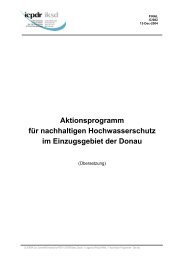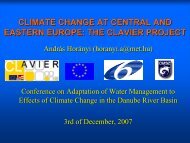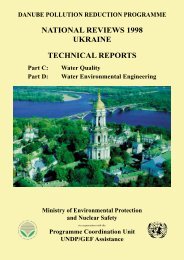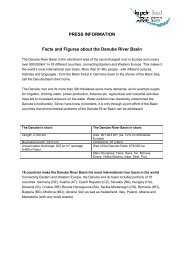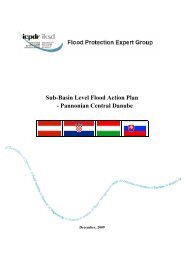1 Review of Agricultural Water Pollution Control Policy and ... - ICPDR
1 Review of Agricultural Water Pollution Control Policy and ... - ICPDR
1 Review of Agricultural Water Pollution Control Policy and ... - ICPDR
Create successful ePaper yourself
Turn your PDF publications into a flip-book with our unique Google optimized e-Paper software.
20<br />
UNDP/GEF Danube Regional Project<br />
• Advisory/informative instruments <strong>and</strong> measures – these use information (e.g. publicity<br />
campaigns) <strong>and</strong> advice (e.g. agricultural extension service) to encourage farmers to voluntarily<br />
change their farming methods in order to reduce the risk <strong>of</strong> water pollution.<br />
• Project-based instruments <strong>and</strong> measures – in some countries the agencies most actively<br />
working on agricultural pollution control are <strong>of</strong>ten operating outside <strong>of</strong> national policy-making<br />
activities <strong>and</strong> are working instead with some other form <strong>of</strong> alternative assistance (e.g. from an<br />
international donor) within the framework <strong>of</strong> a project.<br />
The national experts were advised to be clear about the differences between the policy instruments<br />
that sets the framework for changing agricultural practice, the practical measures that are<br />
encouraged or required at farm level <strong>and</strong> the institutional arrangements for implementing the<br />
various policy instrument <strong>and</strong> measures.<br />
3. The current development <strong>of</strong> existing programmes <strong>and</strong> projects promoting best agricultural<br />
practice for the reduction <strong>of</strong> water pollution by agriculture. For the purposes <strong>of</strong> the questionnaire,<br />
Best <strong>Agricultural</strong> Practice was defined as “those practices <strong>and</strong> activities that reduce the risk <strong>of</strong><br />
causing water pollution <strong>and</strong> that it is reasonable to expect a farmer to do as part <strong>of</strong> the normal dayto-day<br />
management <strong>of</strong> their agricultural enterprises”.<br />
4. The overall effectiveness <strong>of</strong> the “policy mix” used to control water pollution caused by<br />
agriculture. The national experts were advised to be as objective as possible <strong>and</strong> to cover:<br />
a) the effectiveness <strong>of</strong> the policy instruments <strong>and</strong> practical measures being implemented – do<br />
they match the main water pollution problems (nutrients, farm wastes, pesticides <strong>and</strong> soil<br />
erosion)? Do they target all necessary enterprises? Are there any gaps in implementation?<br />
What is the level <strong>of</strong> compliance by farmers? Are the regulations effectively enforced by the<br />
responsible authorities?<br />
b) the effectiveness <strong>of</strong> the institutional arrangements that are operating – including are the<br />
institutions effectively organised to implement policies <strong>and</strong> practice for agricultural pollution<br />
control? Do the relevant institutions have appropriate power <strong>and</strong> authority? Are sufficient<br />
resources allocated to the relevant institutions?<br />
Finally the experts were advised to only review those policies, programmes <strong>and</strong> projects etc that are<br />
directly relevant to the Danube River catchment area in their country. For example – whilst all<br />
national legislation is likely to be relevant, any area specific legislation that does not include territory<br />
<strong>of</strong> the Danube River catchment area is not be relevant.<br />
The GFA national experts completed the questionnaires with the assistance <strong>of</strong> ministry <strong>of</strong>ficials,<br />
research institutions, advisory services <strong>and</strong> by referring to relevant national literature <strong>and</strong> other<br />
sources. The national reports received from the experts are included in the Annexes <strong>of</strong> this review.<br />
Inevitably some <strong>of</strong> the analysis is rather qualitative. The approach <strong>and</strong> scope <strong>of</strong> the project still left<br />
some issues unquestioned especially because investigation <strong>and</strong> evaluation <strong>of</strong> policies remain sensitive<br />
issues in some <strong>of</strong> the countries under study. Furthermore, in some countries the complex political<br />
situation <strong>and</strong> lack <strong>of</strong> transparency did not allow all possible factors to be bought into the review <strong>and</strong><br />
analysis.<br />
In order to address the potential sources <strong>of</strong> error on a country-by-country basis, the results from the<br />
national questionnaires were summarised into tables <strong>and</strong> then grouped into one <strong>of</strong> three categories<br />
according to their status relating to EU accession <strong>and</strong> the associated stages <strong>of</strong> policy design <strong>and</strong><br />
implementation:<br />
EU Acceding<br />
Countries<br />
EU C<strong>and</strong>idate<br />
Countries<br />
Other DRB<br />
Countries<br />
Entering EU in 2004 Czech Republic, Hungary, Slovakia <strong>and</strong> Slovenia<br />
Entering EU after<br />
2004<br />
No immediate plans<br />
for EU entry<br />
Bulgaria, Romania <strong>and</strong> Croatia (preparing<br />
application to join EU)<br />
Bosnia & Herzegovina, Moldova, Serbia &<br />
Montenegro <strong>and</strong> Ukraine



